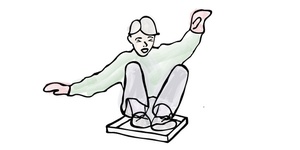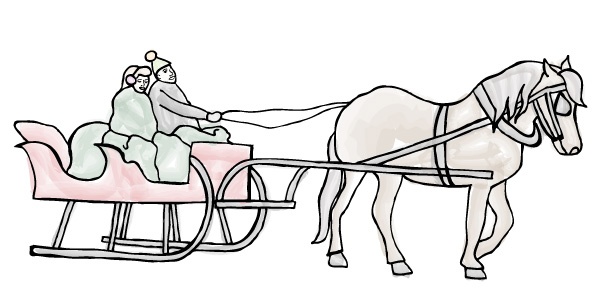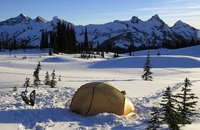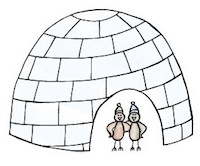All the Types of Sleds and Tubes, Ranked

If you plan on sledding at any point this winter, you have some serious decisions to make. Here’s our definitive guide to all the major types of sleds and tubes, which we’ve ranked in ascending order.
12. Foam Slider
The boogie board of the sledding world. An entry-level sled with two handles and a smooth underbelly.
The Good: Great for young kids, as there’s nothing about a piece of foam that inherently screams “death trap.” Sometimes they’re printed with radical graphics.
The Bad: Doesn’t go very fast. Depending on the thickness of the foam, you might feel some rocks on the way down.
The Verdict: Fine for the kids, but really just a glorified version of training wheels.

11. Cafeteria Tray
Typically used to carry food, the standard plastic cafeteria tray has several other surprising uses.
The Good: Easy to find at your local high school or fast-food establishment. Surprisingly fast.
The Bad: Surface area barely fits the average adult bottom. Theft is immoral.
The Verdict: Not the worst option, but works in a pinch.
10. Saucer
A round, concave sled typically made out of metal or plastic. Lacks runners and any kind of steering mechanism.
The Good: A classic design that can pick up a surprising amount of speed on the right hill.
The Bad: Nearly impossible to maneuver and easy to fall out of. Adults might feel a bit cramped.
The Verdict: Simple and great for small hills, but thrill-seekers can look elsewhere.

9. Horse-Drawn Sleigh
A sled pulled by a horse and meant for flat, snowy terrain. Typically sits two or four.
The Good: A scenic way to travel long distances. The only sled appropriate for marriage proposals.
The Bad: You’ll need to find a horse.
The Verdict: Great for a once-in-a-while treat, but by no means a go-to sledding option.
8. Inflatable Snow Tube
An inflatable, donut-shaped sled filled with air and appropriate for all ages.
The Good: A modern classic. Inexpensive, portable, and extremely lightweight, which matters when you’re carrying it up a hill.
The Bad: Extremely difficult to control, both in terms of speed and maneuvering. This raises the risk of injury, especially when tubing near trees and Yeti caves.
The Verdict: Earns points for its enduring popularity, but loses points for its lack of a steering wheel.
7. Double Inflatable Snow Tube
This sled is shaped like two donuts conjoined at the hip. In all other ways, it’s identical to its single-seat sibling.
The Good: Sledding is more fun with a close friend to blunt the impact of a crash.
The Bad: Control is still an issue, and the front-seat rider is at a more immediate risk.
The Verdict: A great way to show how popular you are, but no fun for people who need to feel in control.
6. Kicksled
A relatively small, chair-shaped sled mounted on two flexible metal runners. These runners extend backward; the rider stands on one while kicking her other foot backward to propel the sled. The runners are flexible, so the driver can steer by twisting the handlebars.
The Good: A surprisingly efficient way to get around, especially on icy or hard-packed snow. The chair seat can be used for a passenger, backpack, or grocery bag. Some kicksleds can be modified for racing.
The Bad: Requires some physical exertion, unless there’s a dog willing to pull the sled along.
The Verdict: The workhorse of the sledding family. Very useful if you live in a snowy climate.
5. Bobsled
A descendent of the classic toboggan, the bobsled is a two- or four-person sled that whips down an icy track with banks and turns. Bobsledding is a popular Winter Olympic sport.
The Good: The epitome of a team sport. Thrilling, viscerally satisfying, and possibly a gateway to Olympic fame.
The Bad: There aren’t many places to do it. You’ll probably have to travel to Lake Placid’s Olympic Sports Complex, which offers one of the country’s only recreational bobsledding experiences.
The Verdict: A superior sledding option, if you don’t mind traveling and listening to a lot of Cool Runnings jokes.
4. Luge
The solo version of the bobsled. Elegant in its simplicity, the typical luge sled consists of two runners connected by a metal crossbar. Riders go down the track on their back, using their hands and body weight to steer the runners.
The Good: It’s a great way to test your manhood. At Muskegon Winter Sports Complex in Michigan, anyone with health insurance and a warm jacket can reach speeds of up to 30 miles per hour on a track designed by three-time Olympian Frank Masley.
The Bad: Muskegon is actually one of the only places you can do it, unless you’re already a pro.
The Verdict: A once-in-a-lifetime experience, though not practical for everyday sledding.
3. Skeleton
The skeleton sled is similar to a luge sled. The big difference is that the rider whips down the track headfirst. The compact sled features metal runners and handles and bumpers along the side to keep the rider stable.
The Good: It’s the closest you’ll ever get to feeling like Superman.
The Bad: It’s absolutely, objectively terrifying.
The Verdict: A superb sledding experience, but strictly for those with ice in their veins.
2. Flexible Flyer
A steerable wooden sled with steel runners. Riders can sit upright or lie down flat on their stomach. A rope or wooden crosspiece controls motion.
The Good: Can be used in a variety of ways, depending on whether you want to tackle the hill feet- or head-first.
The Bad: The runners are quite tall and the sled weighs a lot, so it will probably just sink in deep or soft-packed snow.
The Verdict: Kind of heavy and possibly dangerous, but who cares? The classics never go out of style. Speaking of which …

1. Classic Wooden Toboggan
A simple sled of bound wooden slats bent forward at the front to form a “J” shape. Can fit one or several people.
The Good: What it lacks in skis and runners, it makes up for in old-school style. The preferred sled of Calvin and Hobbes.
The Bad: We will not speak ill of the classic wooden toboggan.
The Verdict: The best way to pass an afternoon after your family disappears.
Illustration: Jess Duff, Groupon

You've traveled through the snow. Now read about how to hunker down in it:

An Eagle Scout’s 10 Tips for Camping in the Snow
